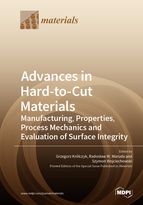Advances in Hard-to-Cut Materials: Manufacturing, Properties, Process Mechanics and Evaluation of Surface Integrity
A special issue of Materials (ISSN 1996-1944).
Deadline for manuscript submissions: closed (30 October 2019) | Viewed by 54231
Special Issue Editors
Interests: surface metrology; optimization of difficult-to-cut materials; sensor technology; metrology; measurement uncertainty; environmental measurement; optimization of geometrical and physical parameters of surface integrity
Special Issues, Collections and Topics in MDPI journals
Interests: machining; powder metalurgy; MQL/MQCL; surface integrity
Interests: ultra-precision and micro-cutting; cutting mechanics; hard-to-cut materials; advances in manufacturing
Special Issues, Collections and Topics in MDPI journals
Special Issue Information
Dear Colleagues,
Hard-to-cut materials have excellent properties, such as a high hardness and abrasion resistance, high strength at room or elevated temperatures, increased thermal conductivity, as well as resistance to oxidation and corrosion. Therefore, these materials are being widely applied in many industries, including automotive, aerospace, medical and electronic. Nevertheless, the unique features of hard-to-cut materials significantly affect their machinability. The fundamental problems occurring during machining of hard-to-cut materials include the high values of cutting forces, high levels of vibrations in machining systems, the concentration of heat, the growth of cutting temperature, rapid tool wear and the risk of catastrophic tool failure, as well as frequent stability loss and a significant deterioration of surface finish. Thus, intensive studies are required for enhancing our knowledge regarding the properties of hard-to-cut materials, phenomena occurring during manufacturing processes, as well as the formation of surface finishes during machining. This knowledge will enable the efficient selection of machining conditions, strategies and types of tools, which allow the improvement of manufacturing performance and economics.
This Special Issue provides an excellent opportunity for researchers who are studying and working with hard-to-cut materials, such as hardened and stainless steels, titanium, cobalt and nickel alloys, composites, ceramics, hard clads fabricated by additive techniques, and others.
It is our pleasure to invite you to submit original research papers, short communications or state-of-the-art reviews which are within the scope of this Special Issue. Contributions can range from property characterization of hard-to-cut-materials, novel approaches in manufacturing, the analysis and modeling of process mechanics, to evaluation of surface integrity.
Prof. Grzegorz M. Królczyk
Prof. Radosław W. Maruda
Dr. Szymon Wojciechowski
Guest Editors
Manuscript Submission Information
Manuscripts should be submitted online at www.mdpi.com by registering and logging in to this website. Once you are registered, click here to go to the submission form. Manuscripts can be submitted until the deadline. All submissions that pass pre-check are peer-reviewed. Accepted papers will be published continuously in the journal (as soon as accepted) and will be listed together on the special issue website. Research articles, review articles as well as short communications are invited. For planned papers, a title and short abstract (about 100 words) can be sent to the Editorial Office for announcement on this website.
Submitted manuscripts should not have been published previously, nor be under consideration for publication elsewhere (except conference proceedings papers). All manuscripts are thoroughly refereed through a single-blind peer-review process. A guide for authors and other relevant information for submission of manuscripts is available on the Instructions for Authors page. Materials is an international peer-reviewed open access semimonthly journal published by MDPI.
Please visit the Instructions for Authors page before submitting a manuscript. The Article Processing Charge (APC) for publication in this open access journal is 2600 CHF (Swiss Francs). Submitted papers should be well formatted and use good English. Authors may use MDPI's English editing service prior to publication or during author revisions.
Keywords
- hard-to-cut materials
- machining
- additive manufacturing
- mechanics
- surface integrity









